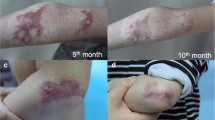Abstract
The management of burn scars has become one of the major clinical challenges in the developing countries which involve enormous treatment cost; this needs new methods for better cost benefit relationship. The objective of the study is to analyze the effectiveness of low-level laser therapy on post-burn scar tissue in children. A randomized controlled study included 15 children, ranging from 2 to 10 years of age, presenting with burn scars. They received diode laser and topical treatment. Each scar was divided into two halves. One half was treated with laser therapy and topical treatment (study area), and the other half was treated with topical treatment only (control area). The children were evaluated before and after 3 months of the study by Vancouver Scar Scale (VSS), ultrasonography (U/S), and laser Doppler perfusion imaging. Significant improvement was reported in the studied area compared to the control area for patients with P values (P = 0.005) and (P = 0.0001) for VSS and U/S scores, respectively. No difference was detected for blood perfusion to the scar between both areas (P = 0.18). In addition, no adverse effect was reported. Photobiomodulation is an efficient and safe therapeutic modality for post-burn hypertrophic scars in children and should be considered a part of combination therapy for better results.




Similar content being viewed by others
Change history
09 January 2021
A Correction to this paper has been published: https://doi.org/10.1007/s10103-020-03194-w
References
Ferguson MW, Duncan J, Bond J, Bush J, Durani P, Laverty H (2009) Prophylactic administration of avotermin for improvement of skin scarring: three double-blind, placebo-controlled, phase I/II studies. Lancet 373(9671):1264–1274
Alster TS, Tanzi EL (2003) Hypertrophic scars and keloids. Am J Clin Dermatol 4(4):235–243
Aarabi S, Longaker MT, Gurtner GC (2007) Hypertrophic scar formation following burns and trauma: new approaches to treatment. PLoS Med 4(9):e234
Kim W-S, Glen Calderhead R (2011) Is light-emitting diode phototherapy (LED-LLLT) really effective? Laser Ther 20(3):205–215
Webb C, Dyson M (2003) The effect of 880 nm low level laser energy on human fibroblast cell numbers: a possible role in hypertrophic wound healing. J Photochem Photobiol B Biol 70(1):39–44
Gauglitz GG (2013) Management of keloids and hypertrophic scars: current and emerging options. Clin Cosmet Investig Dermatol 6:103
Marques NCT, Neto NL, Prado MTO, Vitor LLR, Oliveira RC, et al (2017) Effects of PBM in different energy densities and irradiance on maintaining cell viability and proliferation of pulp fibroblasts from human primary teeth. Lasers Med Sci 32(7):1621–1628
Fearmonti R, Bond J, Erdmann D, Levinson H (2010) A review of scar scales and scar measuring devices. Eplasty 10:e43
Freitas CP, Melo C, Alexandrino AM, Noites A (2013) Efficacy of low-level laser therapy on scar tissue. J Cosmet Laser Ther 15:171–176
Widgerow AD (2011) Cellular/extracellular matrix cross-talk in scar evolution and control. Wound Repair Regen 19(2):117–133
Moravvaej H, Daneshvar L, Saeedi M, Barzegar MR (2011) Treatment of a pigmented hypertrophic scar by low-level laser therapy (LLLT): a case report. J Lasers Med Sci 1(1):35–38
Gaida K, Koller R, Isler C, Aytekin O, Al-Awami M, Meissl G, Frey M (2004) Low level laser therapy—a conservative approach to the burn scar? J Burns 30:362–367
Denise H, Hawkins M, Abrahamse H (2006) The role of laser fluence in cell viability, proliferation, and membrane integrity of wounded human skin fibroblasts following helium-neon laser irradiation. Lasers Surg Med 38(1):74–83
Zungu IL, Hawkins Evans D, Abrahamse H (2009) Mitochondrial responses of normal and injured human skin fibroblasts following low level laser irradiation—an in vitro study. Photochem Photobiol 85(4):987–996
Hawkins D, Abrahamse H (2006) Effect of multiple exposures of low-level laser therapy on the cellular responses of wounded human skin fibroblasts. Photomed Laser Ther 24(6):705–714
Evans DH, Abrahamse H (2008) Efficacy of three different laser wavelengths for in vitro wound healing. Photodermatol Photoimmunol Photomed 24(4):199–210
Brusselaers N, Pirayesh A, Hoeksema H, Verbelen J, Blot S, Monstrey S (2010) Burn scar assessment: a systematic review of objective scar assessment tools. Burns 36:1157–1164
Lindblom L, Cassuto J, Yregård L, Tarnow P, Räntfors J, Hendén PL (2000) Importance of vasoactive intestinal polypeptide in the regulation of burn perfusion. Burns 26(5):435–442
Bray R, Forrester K, Leonard C (2003) Laser Doppler imaging of burn scars: a comparison of wavelength and scanning methods. Burns 29:199–206
Stewart CJ, Frank R, Forrester KR, Tulip J, Lindsay R, Bray RC (2005) A comparison of two laser-based methods for determination of burn scar perfusion: laser Doppler versus laser speckle imaging. Burns 31(6):744–752
Acknowledgements
We would like to thank all workers in pediatrics and burn clinics in Cairo University for their cooperation during the research.
Also ASLM for giving us a chance to attend the conference.
Funding
This research received no grant from any funding agency in the public, commercial, or not-for-profit sectors.
The research was done after the approval of the Laser Institute.
The work received fund from the ASLMS only as a travel grant.
Author information
Authors and Affiliations
Corresponding author
Ethics declarations
Conflict of interest
The authors declare that they have no conflict of interest.
Research ethical committee
All patients and parents approved and signed the informed consent before the treatment; the informed consent contained all the research details.
Rights and permissions
About this article
Cite this article
Alsharnoubi, J., Mohamed, O. & Fawzy, M. Photobiomodulation effect on children’s scars. Lasers Med Sci 33, 497–501 (2018). https://doi.org/10.1007/s10103-017-2387-3
Received:
Accepted:
Published:
Issue Date:
DOI: https://doi.org/10.1007/s10103-017-2387-3




